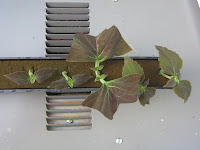Whoever invented Oasis, the lightweight and water-absorbing foam blocks gleefully embraced by flower arrangers, deserves a big thank-you from coleophiles. Now available as little “cubes” (better described as “wedges,” really) nestled neatly into plastic strips, wet Oasis seems to coax roots from a coleus cutting almost overnight. We keep a good supply of the Oasis strips on hand at Atlock Farm, the nursery in central New Jersey where I frequently engage my gardening muse, and over the past month I have put many of them to work.
 It took only two weeks for this little scrap of ‘Red Ruffles’ to send out plenty of healthy white roots within its own private Oasis. >>>>
It took only two weeks for this little scrap of ‘Red Ruffles’ to send out plenty of healthy white roots within its own private Oasis. >>>>
Midsummer – or July, if you subscribe to summer as running from June to August – is the time for assessing and rejuvenating the coleus collection at Atlock. As the practicing Curator of the Coleus Collection (Nice title, yes? Too bad no one else calls me that), I try to set aside three healthy, typical-looking specimens of every selection in the collection before all of the plants of a given coleus are sold, are discarded during the necessary end-of-July purge, or meet some other fate. Quite a few plants end up in #10, the little greenhouse-cum-ark where they are assembled three by three, but every year some cultivars inevitably fall through the cracks. So after making a list of the ones not yet set aside, I make my way through the collection of mature stock plants, taking the necessary cuttings and inserting them into the aforementioned Oasis oases.
 <<<< Like the cuttings of ‘Red Ruffles’, sections of 28 different cultivars quickly rooted into their Oasis bits and were then moved into four-inch pots.
<<<< Like the cuttings of ‘Red Ruffles’, sections of 28 different cultivars quickly rooted into their Oasis bits and were then moved into four-inch pots.
Don’t think for even a minute that the same list of coleus cultivars is propagated, offered for sale, and prepared for overwintering year in and year out. While we have many long-time favorites at Atlock, some cultivars fail to make the cut each year: they develop a disease or other cultural problem, or every example of the original cultivar sports and/or reverts (so the cultivar is lost to us unless acquired elsewhere). Some fall out of favor because they resemble a superior selection too closely, or they no longer appeal to the Curator, El Jefe (otherwise known as Ken Selody, owner of Atlock Farm), or customers. While we want to offer a wide selection of superior coleus, we don’t want to spend time, effort, and resources on also-rans.
And then of course there are always some New Ones, bought on field trips to nurseries, obtained from fellow coleophiles, or discovered on the nursery premises as sports, reversions, or seedlings. (I introduced you to one enticing seedling in my previous blog entry, and at least one future missive will discuss other New Ones.) Just like the veterans, three suitably sized plants of each New One need to be on hand around the beginning of August for official addition to the collection. Out come the scissors, off come a few shoots, and into the Oasis the little cuttings go.
Within a week from today (August 2), cuttings of the most recently acquired cultivar – the elongate-leaved, richly earth-toned ‘Lancelot Velvet Mocha’ from Proven Winners – should have rooted into their chunks of Oasis, and then the three best-looking ones will be potted up and added to the assembled multitude. In a few more weeks, after completing our yearly ritual of potting the vigorously growing, neophyte stock plants into roomy hanging baskets, the entire collection – labeled, recorded, and otherwise duly curated – will begin settling in for winter.
Yes, some coleus growers plan for winter in July. And in winter we dream about July’s warm Oasis.
















